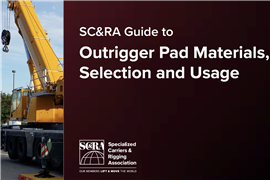Building Blocks
20 March 2008

If there is any type of equipment for which effective control is important, it is MEWPs and telehandlers. Booms and scissors amplify at the basket or fork end move mentsof actuators far down the chain of linked mechanical assemblies, and deflections of structural members can significantly affect performance, operator comfort and safety.
Control of movement is therefore critical, and systems to do that come in two basic types – hydraulic and electrical. However, technology advances might just be blurring the divide between the two.
For example, Bosch Rexroth's new variable displacement pump, the A10VO series 53, gives equipment designers for the first time, says the German company, the choice of hydraulic–mechanical power control or electro–proportional differential pressure control in a medium–duty, axial piston pump.
The pumps, suitable for 250 to 315 bar use, are the basis for adaptable, fully electro–hydraulic systems to ensures sufficient flow in the system to meet varying demands from individual actuators and motors. Doing so makes the system more responsive and reduces sensitivity to disturbances.
Hydrostatic motors
Also combining hydraulics and electrics is a new hydrostatic motor range from Sauer–Danfoss, called the H1. It is the only electrically controlled motor on the market, says the German company, and it allows users to change motor responsiveness to their control movements.
The smallest model available now is sized at 45 cc/rev, but the company said the range will “soon” include 20 to 45 cc capacity versions for MEWPs.
Sauer–Danfoss has also a new direct displacement control pump, which it says increases machine life and lowers noise levels. The pump's distinguishing characteristic is that its neutral return mechanism (the device that returns the swash plate to the neutral position) – common in all such pumps – is inside the pump.
Linde Hydraulics in the US has a new pump, too: the HPV–02 CA axial piston pump, designed specifically for telehandlers. Speed controlled, it features optional secondary control of hydraulic motors for continous output control using the accelerator pedal.
Other manufacturers, meanwhile, strive to more effectively transfer mechanical power. For example, the US's Dana Corporation offers its new Spicer four–speed, 800 Nm of output torque, HSR08 power shuttle transmission for telehandlers with engines up to 88 kW.
ZF in Germany has a new hydrostatic transmission, the HC 85, for equipment up to 9.5 t. It provides continuously variable vehicle speeds up to 42 km/h and offers improved mechanical efficiencies, says the company, leading to fuel savings.
System control
Component suppliers are also making improvements in control capabilities at a higher, or systems level, as well.
Rexroth, for example, has eliminated the need for pressure control loops in conventional flow–sharing hydraulic (LUDV) circuits. Its new electro–hydraulic flow matching (EFM) control system – referred to previously – generates a signal to adjust pump output at the same time that it sends signals to valves.
Hirschmann has added its Compact and Superior products to its iFlex family of control systems. The Superior range supports both CANOpen and Ethernet data communication protocols, allowing OEMs to integrate a wider range of devices using a single controller.
The new electronic control system for hydrostatic transmissions from Poclain, called SmartDrive Easy, uses a CAN–bus link between engine and pump. Benefits are automotive–style driving, better speed regulation, and braking assistance.
Sauer Danfoss' latest version of its Guide software, used with its Plus+1 range of components, “makes it easier than ever for customers to develop complex control solutions…for electro–hydraulic systems,” says Fred Bezat, the company's application software product manager.
Additional blocks of software describe the operating characteristics of its components products, making it easier for OEM engineers to integrate them into designs. One benefit, says Mr Bezat, is that it “gives small– and medium–sized companies the same [control system design] capabilites as bigger companies.”
Linde Hydraulics, as well, has new software. Its LinDiag product allows easy set–up and fast diagnosis of its CED and CEB electronic control units for drives in both closed–loop and open–loop applications. Using the software optimises the drive system, while the ‘teach–in–function’ matches Linde's system components – joystick, pedal, diesel engine, hydraulic pump and motor.
Information display
Flexibility is one benefit of new graphical display units; meters and dials may become obsolete. For example, Rexroth's 640 x 480 pixel, colour, high–resolution BODAS D13 unit displays any information available from the control system, including dynamic data.
Sauer–Danfoss' new display product is the DP200 Series graphical terminal. It presents engine, hydraulic, and equipment performance data in a mono–chrome, back–light display unit.
The unit has an optional USB port for connecting a PC to a CAN network, providing a gateway for measuring performance, diagnosing faults and adjusting parameters.
Germany's Hirschmann launched at Bauma its iScout consoles, whose higher–end versions function also as controllers. The iScout expert–compact console displays information over a 165 mm, 256–colour display, while the Scalable Mobile family adopts different–sized displays and various microprocessors, depending on the number of signal inputs and outputs and the operating concept of the equipment.
Smaller components, too
It is not just big, complex components that have received engineering attention, and you'll find bearings of some sort and size in every access platform. SKF's new range, called Hi–TF, incorporate a new material and a new heat treatment technology to offer longer service lives.
Linde wants to make hydraulic systems simpler, and its LSC (Synchronous Control Counts) modular valve plate system integrates various valve functions in its block and eliminates hoses and pipes. Precise, proportionate actuator control takes place either hydraulically or electrically.
Axiomatic's valve controller, the AX021300, is part of the trend toward flexible, integrated hydraulic components. Designed for both CANOpen or SAE J1939 networks to control up to six on/off valves, its embedded software provides functional and signal flexibility across all outputs and two analogue and three digital inputs.
Eaton Fluid Power has a new, thread–less connector that plugs straight into threaded ports without an adapter. According to the US company, the system makes on–site repairs quicker and simpler.
So, whether they are hydraulic, mechanical, or electronic, new components provide, directly or indirectly, the control necessary for better, more effective access platforms.


